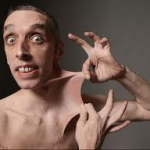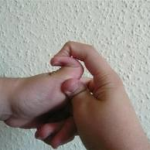Ehlers–Danlos syndrome (EDS) (also known as Cutis hyperelastica) is a group of inherited connective tissue disorders, caused by a defect in the synthesis of collagen (Type I or III). The collagen, often referred to as “glue”, in connective tissue helps tissues to resist deformation. Collagen plays a very significant role in the skin, joints, muscles, ligaments, blood vessels and visceral organs; abnormal collagen leads to increased elasticity within these structures. Depending on the individual, the severity of the mutation can vary from mild to life-threatening. There is no cure, and treatment is supportive, including close monitoring of the digestive, excretory and particularly the cardiovascular systems. Physical therapy, bracing, and corrective surgery may help with the frequent injuries and pain that tend to develop in certain types of EDS, although extra caution is advised and special practices should be observed to prevent permanant damage.
The syndrome is named after two doctors, Edvard Ehlers of Denmark, and Henri-Alexandre Danlos of France, who identified it at the turn of the 20th century.
Classification
In the past, there were 10 recognized types of Ehlers–Danlos syndrome. In 1997, researchers proposed a simpler classification that reduced the number of major types to six and gave them descriptive names. These six major types are listed here. Other types of the condition may exist, but they have been reported only in single families or are not well characterized. Except for hypermobility, the specific mutations involved have been identified and they can be precisely identified by genetic testing; this is valuable due to a great deal of variation in individual cases. Although the following classifications are well defined, it is rare for a case to fit neatly in a single category, and cross-over symptoms lead to under-diagnosis or mis-diagnosis. Therefore, patients should not rely on the “fact” of having a certain type of EDS if cross-over symptoms are evident because of possibly life-threatening symptoms. For example, it is possible for an individual with Classical EDS to exhibit symptoms of Hypermobility or Vascular EDS. In order of prevalence in the population, the classifications are:
|
Name |
Number |
Description |
OMIM | Gene(s) |
| Hypermobility | type 3 |  Affects 1 in 10,000 to 15,000 and is caused by an autosomal dominant or autosomal recessive mechanism. Mutations in either of two separate genes (which are also involved in Vascular EDS and Tenascin-X deficiency EDS, respectively) may lead to this variant. Joint hypermobility is the hallmark of this type, with less severe skin manifestations. Joint instability and chronic musculoskeletal pain are common in this type. Affects 1 in 10,000 to 15,000 and is caused by an autosomal dominant or autosomal recessive mechanism. Mutations in either of two separate genes (which are also involved in Vascular EDS and Tenascin-X deficiency EDS, respectively) may lead to this variant. Joint hypermobility is the hallmark of this type, with less severe skin manifestations. Joint instability and chronic musculoskeletal pain are common in this type. |
130020 | COL3A1, TNXB |
| Classical | types 1 & 2 | Affects approximately 1 in 20,000 to 50,000 people. It is caused by autosomal dominant mechanism and affects type-V collagen, as well as type I. Type 1 typically presents with severe skin involvement, and type 2 presents with mild to moderate skin involvement. | 130000, 130010 | COL5A1, COL5A2,  COL1A1 |
| Vascular | type 4 | Is an autosomal dominant defect in the type-III collagen synthesis; affecting  approximately 1 in 100,000 to 250,000 people. The vascular type is considered  one of the more serious forms of Ehlers–Danlos syndrome because blood vessels  and organs are fragile and prone to tearing (rupture). Many patients with EDS  type 4 express a characteristic facial appearance (large eyes, small chin, sunken cheeks, thin nose and lips, lobeless ears), have a small stature with a slim build, and typically have thin, pale, translucent skin (veins can usually be seen on the chest and abdomen) with very easy bruising and propensity to develop ecchymoses. About one in four people with vascular type EDS develop a significant health problem by age 20 and more than 80 percent develop life-threatening complications by age 40. | 130050 | COL3A1 |
| Kyphoscoliosis | type 6 | Is an autosomal recessive defect due to deficiency of an enzyme called lysyl hydroxylase; it is very rare, with fewer than 60 cases reported. The kyphoscoliosis type is characterised by progressive curvature of the spine (scoliosis), fragile eyes, and severe muscle weakness. | 225400, 229200 | PLOD1 |
| Arthrochalasis | types 7A & B | Is also very rare, with about 30 cases reported. It affects type-I collagen. The arthrochalasia type is characterised by very loose joints and dislocations involving both hips. | 130060 | COL1A1, COL1A2 |
| Dermatosparaxis | type 7C | Also very rare, with about 10 cases reported. The dermatosparaxis type is characterised by extremely fragile and sagging skin. | 225410 | ADAMTS2 |
Other types
“The large number of distinct types of the Ehlers–Danlos syndrome that have already been identified indicates great heterogeneity, but clearly that heterogeneity is not exhausted by the present classification.” Forms of EDS within this category may present with soft, mildly stretchable skin, shortened bones, chronic diarrhea, joint hypermobility and dislocation, bladder rupture, or poor wound healing. Inheritance patterns within this group include X-linked recessive, autosomal dominant, and autosomal recessive. Examples of types of related syndromes other than those above reported in the medical literature include:
- 305200 – Type 5
- 130080 – Type 8 – unspecified gene, locus 12p13
- 225310 – Type 10 – unspecified gene, locus 2q34
- 608763 – Beasley-Cohen type
- 130070 – Progeroid form – B4GALT7
- 606408 – Due to Tenascin-X deficiency – TNXB
- 130090 – Type unspecified
- 601776 – D4ST1-Deficient Ehlers-Danlos syndrome (Adducted Thumb-Clubfoot Syndrome) CHST14

